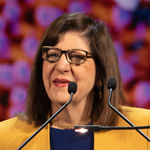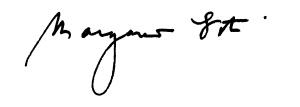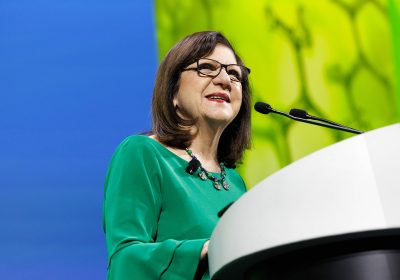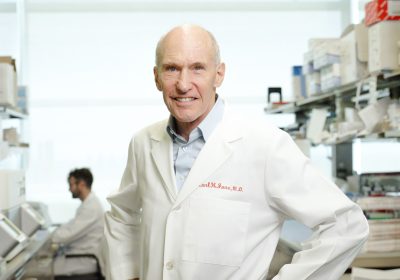A Transformational Era in Cancer Research

Last October, the National Foundation for Cancer Research honored me with its 2024 Beacon Award for Women Leaders in Oncology. The award, presented at the National Press Club in Washington, D.C., caused me to reflect on the many years I have worked at the American Association for Cancer Research® (AACR) with some of the most brilliant and important cancer researchers and clinicians in the world.
I came to the AACR as an editorial assistant for Cancer Research, hired by the journal’s editor, Michael B. Shimkin, MD. At the time, Cancer Research was the AACR’s only journal and the most prestigious cancer journal of its day. Four years after starting at the AACR, Sidney Weinhouse, PhD, editor of Cancer Research, asked me to be managing editor of the journal. I was a rarity in the world of cancer research: just 24 years old and a woman. In 1982, Bayard D. (Barney) Clarkson, MD, and the AACR Board appointed me as executive director and CEO of the AACR.
Looking back on my long career, I realize my earliest successes were due to the support of senior male scientists, like Dr. Shimkin, Dr. Weinhouse, and Dr. Clarkson, who were willing to take a chance on a very young woman and ask her to shoulder significant responsibilities. Female scientists have not always been as fortunate as I was. The data show that while 36% of the U.S. oncology workforce are women, they are still seriously underrepresented in leadership roles, even at National Cancer Institute (NCI)-designated cancer centers, where only 16% of cancer center directors are women.
I am proud to say that 25 years ago, the AACR launched the Women in Cancer Research (WICR) Council to recognize women’s scientific achievements and to foster their career development and advancement in cancer research. Female scientists, indeed all scientists, would benefit from learning skills for tackling professional hurdles and gender discrimination, navigating a scientific world of scarce resources, and developing leadership capabilities. WICR offers women the opportunity to learn these skills.
The AACR has been recognized as an organization that opens doors for women. In 2018, I received the Women for Oncology Award from the European Society for Medical Oncology in recognition of the AACR’s enviable position of having the highest percentage of women in leadership positions in our field, at the time 46%, compared to as low as 7% for other cancer organizations. Our track record in electing female presidents of the AACR is impressive compared with other scientific and clinical organizations. Since the turn of the century, 10 women have been AACR presidents, including our current president, Patricia M. LoRusso, DO, PhD (hc). Our next president, Lillian L. Siu, MD, will take the AACR leadership reins in April 2025, our 11th female president since 2000.
We are now in a transformational era in cancer science and medicine. The pace of discovery and technological advances in our field is breathtaking. Rapid progress in artificial intelligence is predicted to drive breakthroughs in diagnostics, early detection, and treatment, improving patient outcomes and survival rates. As we begin to leverage advanced technologies, it is critical that the sources of data used to train these systems and the workforce developing them are representative of all populations—women and men, of all races and ethnicities, and from around the world.
Addressing the range of cancer disparities, both in the cancer research community and in the wider world of patient care, is one of the most significant public health challenges in the U.S. and globally. Finding a solution will require the concerted efforts of all stakeholders. I am very proud that the AACR, because of the remarkable brain trust and wide range of disciplines in its membership, will continue to be an extraordinary force for accelerating progress. Because of its size and influence, the AACR has the enormous responsibility to present the latest findings in cancer research, stimulate the integration of disciplines, speed new drug discoveries among academics and entrepreneurs, and fund promising research.
Collaboration is key! If we are to make rapid advances against cancer, all sectors—academia, industry, government, scientific societies, and patient advocacy and philanthropic organizations—need to find new ways to work synergistically. With a full-court press against cancer in all its forms, we will be able to move closer to a time when cancer is a treatable and even preventable disease!


Margaret Foti, PhD, MD (hc)
AACR Chief Executive Officer





